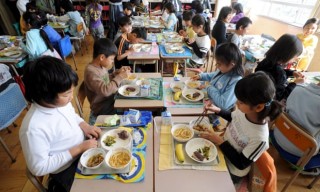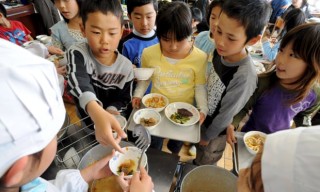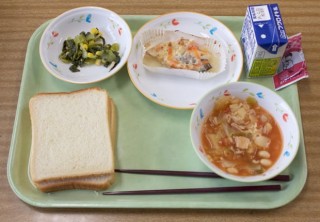Loading
Search
▼ Baked Cod, Miso And Bok Choy: Unpacking Japan's Healthy School Lunches
- Category:Experience
The list of dishes reads like a health-conscious menu at an upmarket cafe: mackerel cooked in miso, a light salad of daikon radish and sour plum, thinly sliced pickled vegetables and a selection of fresh fruit. But the “restaurant” is actually a classroom at Konan primary school in central Japan, where the pupils need only the gentlest encouragement to eat their greens.
When the Guardian visited the school in the Pacific coastal city of Fukuroi, the classroom, momentarily transformed into a lunchtime cafeteria, reverberated to a chorus of “Itadakimasu” – a polite Japanese term for “let’s eat”.
On the menu today is baked cod, sautéed sweet corn and bok choy, minestrone soup, a small carton of milk and, as a Friday treat, a slightly less wholesome combination of white bread with a soy-based chocolate “cream” – a challenge to spread evenly on the bread with chopsticks.
The portions are modest, but then so is the total calorie count – 667 kcal for a meal that will sustain the 11-year-old children until they get home.
Konan is not the only school in Japan producing a range of lunches – or kyushoku – that combine flavour with fresh ingredients and contain levels of iron, calcium and fibre stipulated by a government-run programme for children attending kindergarten through to the end of junior high school.
The kyushoku system was introduced in the 1950s to ensure that children did not have experience the dietary privations of the immediate postwar years. More than seven decades on, the programme is credited with contributing to Japan’s impressive life expectancy, and child and adult obesity levels that are among the lowest in the OECD group of nations.
Local officials refer to their school meals as the healthiest in a country with one of the healthiest cuisines in the world. It is no empty boast: last year Fukuroi won a World Health Organization best practice award for promoting healthy dietary habits among schoolchildren, with the help of local producers.
The city’s school lunch centres prepare and send out more than 10,000 lunches to kindergartens, primary and junior high schools every day. Most of the meals are inspired by Japanese cuisine, with the occasional inclusion of Chinese, Korean and European dishes. Parents pay ¥250 (£1.70) a meal, about half of what they cost to make, with the local government contributing the rest.
“We devise the monthly menu so that there is something different every day,” says Koji Ishizuka, the manager of the school lunch division at the city’s board of education. “And each month differs depending on what’s in season.” In 2005, the government took its school lunch programme a step further by requiring school boards to educate children about the provenance and composition of their lunches.
As the children at Konan tuck into lunch, Mihoko Kobayashi, one of two nutrition educators in Fukuroi, tells them where the bok choy they are eating was grown and why, despite clear reservations among some pupils, they should eat every last morsel.
“Please remember that a lot of people were involved in preparing your lunch,” she says. “Especially when you come across a vegetable you think you won’t like.”
The bok choy converts have Toshiyuki Suzuki to thank for a portion of their lunch. The local farmer sends 4 tonnes of the leafy vegetable to Fukuroi schools every year. “Freshness is absolutely essential,” he says.
“The vegetables I sell commercially have to go through a distribution system, but I sell directly to schools, so the vegetables the kids are eating are the freshest around.”
Working closely with the city’s board of education, Suzuki and other farmers in the area have helped push the proportion of locally grown vegetables in school meals from just over 13 % in 2012 to almost 32% last year.
“Children generally acquire their long-term eating habits by the time they’re 10, so that’s why we think school lunches are so important,” says Ishizuka. “The results of regular health checks on the children are generally good, and we believe school lunches have something to do with that.”
Since its inception, the kyushoku programme has been taken up by almost all primary schools and about 80% of junior high schools, according to education officials.
Dr Atsushi Miyawaki, a health policy specialist at Tokyo University’s graduate school of medicine, says removing choice from the menu and banning packed lunches are the “most remarkable” features of the programme. “It offers a uniform menu to all children in each school five days a week, unlike the cafeteria-style school lunches often found in the US and UK,” Miyawaki says. “That means the children have no choice regarding menu items, or whether to eat school lunch or bring it from home.
“That helps avoid an imbalance in nutritional intakes. And the lack of choice can help hide disparities in the children’s socioeconomic background that may be evident in packed lunches.”
The lunch break is coming to an end for year 5, class 3. There is not a single leftover vegetable or cod flake to be seen, supporting staff claims that the children eat 95% of the food they’re given. A quick survey of the Guardian’s dining companions reveals, unsurprisingly, that the bread with chocolate spread is a big hit.
The lunch monitors load trays of empty plates on to trolleys and wheel them to the kitchen while their classmates file out to complete the final task of their day’s food education: brushing their teeth.
When the Guardian visited the school in the Pacific coastal city of Fukuroi, the classroom, momentarily transformed into a lunchtime cafeteria, reverberated to a chorus of “Itadakimasu” – a polite Japanese term for “let’s eat”.
On the menu today is baked cod, sautéed sweet corn and bok choy, minestrone soup, a small carton of milk and, as a Friday treat, a slightly less wholesome combination of white bread with a soy-based chocolate “cream” – a challenge to spread evenly on the bread with chopsticks.
The portions are modest, but then so is the total calorie count – 667 kcal for a meal that will sustain the 11-year-old children until they get home.
‘Something different every day’
Konan is not the only school in Japan producing a range of lunches – or kyushoku – that combine flavour with fresh ingredients and contain levels of iron, calcium and fibre stipulated by a government-run programme for children attending kindergarten through to the end of junior high school.
The kyushoku system was introduced in the 1950s to ensure that children did not have experience the dietary privations of the immediate postwar years. More than seven decades on, the programme is credited with contributing to Japan’s impressive life expectancy, and child and adult obesity levels that are among the lowest in the OECD group of nations.
Local officials refer to their school meals as the healthiest in a country with one of the healthiest cuisines in the world. It is no empty boast: last year Fukuroi won a World Health Organization best practice award for promoting healthy dietary habits among schoolchildren, with the help of local producers.
The city’s school lunch centres prepare and send out more than 10,000 lunches to kindergartens, primary and junior high schools every day. Most of the meals are inspired by Japanese cuisine, with the occasional inclusion of Chinese, Korean and European dishes. Parents pay ¥250 (£1.70) a meal, about half of what they cost to make, with the local government contributing the rest.
“We devise the monthly menu so that there is something different every day,” says Koji Ishizuka, the manager of the school lunch division at the city’s board of education. “And each month differs depending on what’s in season.” In 2005, the government took its school lunch programme a step further by requiring school boards to educate children about the provenance and composition of their lunches.
As the children at Konan tuck into lunch, Mihoko Kobayashi, one of two nutrition educators in Fukuroi, tells them where the bok choy they are eating was grown and why, despite clear reservations among some pupils, they should eat every last morsel.
“Please remember that a lot of people were involved in preparing your lunch,” she says. “Especially when you come across a vegetable you think you won’t like.”
The joy of no choice
The bok choy converts have Toshiyuki Suzuki to thank for a portion of their lunch. The local farmer sends 4 tonnes of the leafy vegetable to Fukuroi schools every year. “Freshness is absolutely essential,” he says.
“The vegetables I sell commercially have to go through a distribution system, but I sell directly to schools, so the vegetables the kids are eating are the freshest around.”
Working closely with the city’s board of education, Suzuki and other farmers in the area have helped push the proportion of locally grown vegetables in school meals from just over 13 % in 2012 to almost 32% last year.
“Children generally acquire their long-term eating habits by the time they’re 10, so that’s why we think school lunches are so important,” says Ishizuka. “The results of regular health checks on the children are generally good, and we believe school lunches have something to do with that.”
Since its inception, the kyushoku programme has been taken up by almost all primary schools and about 80% of junior high schools, according to education officials.
Dr Atsushi Miyawaki, a health policy specialist at Tokyo University’s graduate school of medicine, says removing choice from the menu and banning packed lunches are the “most remarkable” features of the programme. “It offers a uniform menu to all children in each school five days a week, unlike the cafeteria-style school lunches often found in the US and UK,” Miyawaki says. “That means the children have no choice regarding menu items, or whether to eat school lunch or bring it from home.
“That helps avoid an imbalance in nutritional intakes. And the lack of choice can help hide disparities in the children’s socioeconomic background that may be evident in packed lunches.”
The lunch break is coming to an end for year 5, class 3. There is not a single leftover vegetable or cod flake to be seen, supporting staff claims that the children eat 95% of the food they’re given. A quick survey of the Guardian’s dining companions reveals, unsurprisingly, that the bread with chocolate spread is a big hit.
The lunch monitors load trays of empty plates on to trolleys and wheel them to the kitchen while their classmates file out to complete the final task of their day’s food education: brushing their teeth.
- March 2, 2019
- Comment (0)
- Trackback(0)




